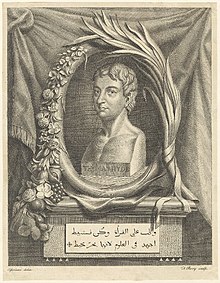Thomas Hyde
Thomas Hyde | |
|---|---|
 Line engraving by Francis Perry, 1767 | |
| Born | 29 June 1636 |
| Died | 18 February 1703 (aged 66) |
| Nationality | British |
| Academic background | |
| Alma mater | King's College, Cambridge |
| Influences | University of Oxford |
| Academic work | |
| Sub-discipline | Hebrew studies |
Thomas Hyde (29 June 1636 – 18 February 1703) was an English
Life
He was born at Billingsley, near Bridgnorth in Shropshire, on 29 June 1636. He inherited his taste for linguistic studies, and received his first lessons in some of the Eastern tongues, from his father, who was rector of the parish.[1]
Hyde was educated at
In 1658 he was chosen Hebrew reader at
In 1691 the death of
Under Charles II, James II and William III, Hyde discharged the duties of Eastern interpreter to the court. He resigned his librarianship in 1701,[1] giving as a reason, "my feet being left weak by the gout, I am weary of the toil and drudgery of daily attendance all times and weathers."[4] He died at Oxford on 18 February 1703, aged 66.
Works
Hyde was an assiduous classical scholar and linguist who helped popularize
His writings and translations include:
- Tabulae Long. ac Lat. Stellarum Fixarum ex Observatione Ulugh Beighi, Tamerlanis Magni Nepotis... [Tables of the Longitudes and Latitudes of the Fixed Stars from the Observatory of Ulugh Beg, Grandson of Timur the Great...] (in Latin), Oxford: Henry Hall, 1665, a translation of the c. 1438 Zij-i Sultani
- Jang Ampat Evangelia derri Tuan Kita Jesu Christi, daan Berboatan derri Jang Apostoli Bersacti, Bersalin dallam Bassa Malayo, That Is, The Four Gospels of Our Lord Jesus Christ, and the Acts of the Holy Apostles, Translated into the Malayan Tongue (in English and Malay), Oxford: Sheldonian Theater, 1677, a combination of the separate translations of the J. Van Heurn, and J. Van Hasel with an English foreword by Hyde introducing the Malay language, its orthography, and its grammar.
- "De Mensuribus et Ponderibus Sinensium Epistola [Letter on Chinese Weights and Measures]", De Mensuris et Ponderibus Antiquis Libri Tres [Three Books on Ancient Weights and Measures] (in Latin), Oxford: Sheldonian Theater, 1688, pp. 312-349.
- אגרת אורחות שלם Id Est, Itinera Mundi, Sic Dicta Nempe Cosmographia... [The Letter on the Paths of the World, That Is, The Paths of the World, Thus Certainly Called the Cosmography...] (in Latin), Oxford: Sheldonian Theater, 1691, a translation of Iggeret Orḥot 'Olam.
- De Ludis Orientalibus Libri Duo... [Two Books on Eastern Games...] (in Latin), vol. I & II], Oxford: Sheldonian Theater, 1694.[1]
- Historia Religionis Veterum Persarum, Eorumque Magorum... [History of the Religion of the Ancient Persians and That of the Magi] (in Latin), Oxford: Sheldonian Theater, 1700.
In parts of the De Ludis Orientalibus, he relates his understanding of various Chinese games as explained to him by Michael Shen. These include
See also
Notes
- ^ a b c d e f g h i j One or more of the preceding sentences incorporates text from a publication now in the public domain: Chisholm, Hugh, ed. (1911). "Hyde, Thomas". Encyclopædia Britannica. Vol. 14 (11th ed.). Cambridge University Press. p. 30.
- ^ "Hyde, Thomas (HD652T)". A Cambridge Alumni Database. University of Cambridge.
- ^ Alumni Oxonienses 1500-1714, Horrobin-Hyte
- William D. Macray, Annals of the Bodleian Library (1868) p. 121-122.
- ^ Maverick, Lewis A. (February 1952), "Review of A Cycle of Cathay: The Chinese Vogue in England during the Seventeenth and Eighteenth Centuries by William W. Appleton", Far Eastern Quarterly, vol. 11, pp. 246–247.
- ^ Ballaster, p. 262.
- ^ "Zoroaster as Perceived in Western Europe after Antiquity", Iranica, archived from the original on 16 April 2019, retrieved 20 September 2007.
- ^ "cuneiform", Online Etymology Dictionary.
- ^ "cuneiform, n. and adj.", Oxford English Dictionary, Oxford: Oxford University Press, 2021.
- ^ Hyde, HRVP (1700), p. 526.
- ISBN 9004038582.
- S2CID 242249340.
- ^ De Ludis Orientalibus, Vol. II (1694), pp. 195–201.

